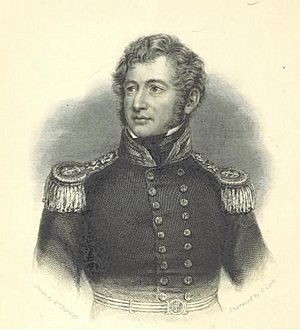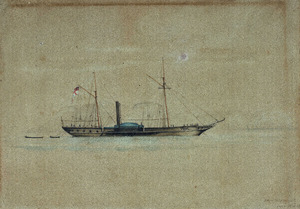William Allen (Royal Navy officer) facts for kids
Rear-Admiral William Allen (born 1792, died 1864) was an English naval officer and explorer. He was also a member of the Royal Society, a famous group of scientists. Allen explored different parts of the world, including Africa and the Middle East, and wrote books about his adventures.
William Allen's Adventures
William Allen was born in Weymouth, England, in November 1792. He joined the navy as a volunteer when he was just 13 years old in 1805. As a midshipman, he was part of the navy's journey through the Dardanelles in 1807.
In August 1811, he was on a ship called the HMS Leda when it helped capture Java. Later, in June 1813, he was involved in a successful attack on a pirate base in Sambas, Borneo.
Allen moved up in the navy, becoming a lieutenant in 1815. He was promoted to commander in 1836 and then captain in 1842. He took part in an expedition to the River Niger in 1832 with explorers Richard Lander and Oldfield.
He is most famous for commanding the steamship HMS Wilberforce during a large but difficult expedition to the River Niger in 1841. This trip was led by Captain Henry Trotter. Even though Allen was not to blame for the problems on this journey, he was put on "half-pay" when he returned. This meant he received only half his usual salary. He later retired from the navy as a rear-admiral in 1862 and passed away in Weymouth on January 23, 1864.
During his explorations, Allen collected a special type of small waterbird near the River Niger. This bird was later named Allen's gallinule after him.
What Did William Allen Write?
In 1848, Allen worked with Thomas Richard Heywood Thomson to publish a two-volume book. It was called A Narrative of the Expedition sent by H.M.'s Government to the River Niger in 1841. This book told the story of the challenging Niger expedition.
In 1849, Allen traveled through Syria and Palestine. He wrote about his experiences in a two-volume book published in 1855. It was titled The Dead Sea, a New Route to India, with other Fragments and Gleanings in the East. In this book, he suggested building a canal between the Mediterranean Sea and the Red Sea. He thought this canal could go through the Jordan Valley and the Dead Sea. He also compared his idea to the Suez Canal, which was being planned at the time.
Allen also wrote other works. In 1846, he published a small book called Mutual Improvement. In it, he suggested giving awards for good behavior, chosen by groups of people. In 1849, he published a plan to stop the slave trade and help the West Indies. He also wanted to spread civilization and Christianity in Africa.
He also created two books of Picturesque Views, showing scenes from Ascension Island (1835) and the River Niger (1840). He wrote articles for the Journal of the Royal Geographical Society. Some of his landscape paintings were shown at the Royal Academy between 1828 and 1847.



